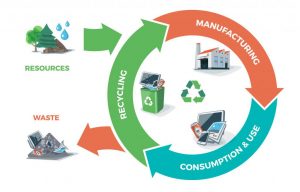Report on circular economy: advantages
According to Ellen MacArthur, the circular economy is “industrial economy that is conceptually regenerative and reproduces nature is actively improving and optimizing the systems through which it operates”. The circular economy as the theory states that wastes do not exist. The biological and technical components of a product are designed with the assumption of fit within a materials cycle, designed for disassembly and re-purposing. The organic nutrients are non-toxic and can simply be composted. The technical nutrients – polymers, alloys, and other artificial materials – are designed to be used again with minimum energy expenditure. The circular is, therefore, a form of economy that is more collaborative, which focuses on the property and not so much the product as such, but its function and its use. The circular economy is an economy in which waste of a process of production and consumption are circulating as a new entry in the same or a different process (Cavallo 2018).

Image source: https://ec.europa.eu/jrc/en/news/research-helps-europe-advance-towards-circular-economy
The circular economy will have a positive impact on economical growth. Until 2030, it could possibly reach up to 4.5 trillion dollars globally. The economical model “take, make, throw” is not sustainable anymore and there will be more environmental degradation if there will be no changes in waste management. According to the EU, the need for new raw material could be reduced in percentages of 17-24% and the savings for the European industry estimated at 630 billion euro annually if there will be a more efficient use of raw materials and resources throughout the supply chain materials. Thus the European Industry could raise the European GDP by about 3.9% and create new jobs. Also, circular economy could save 8% of annual turnover to the industries and reduce its total annual emissions of greenhouse gases by 2.4%. All this inevitably leads in a bigger cooperation between companies, but also between the public administration, research and companies themselves to find new operational solutions. Companies cannot think only about their business, but they have to assess the impact of their actions on the surrounding environment, confronting all other economic actors. Working on a circular economy basis means to focus on products with a bigger lifetime, improved, more durable, with taking into consideration strategies such as sustainable design (Cavallo 2018).
In general, a circular economy (for nutrients and other resources) begins by making sure that nutrients and other resources are used efficiently, by limiting wastage and by avoiding leakages. The mineral fertilizer industry is already strongly engaged in this process, aiming at an industrial symbiosis. Ultimately, it is a challenge for the whole society, and other sectors producing waste streams (like the livestock sector) should make similar efforts too (European Food Sustainable Consumption & Production Round Table, 2018).
Some advantages of the circular economy are shown in this paragraph. Companies in the framework of circular economy will be more effective and thus more competitive. Furthermore, nowadays consumers are well informed about environmental degradation and climate change, thus they prefer to buy a product that is produced in a more environmentally friendly way and the least impact on the environment. Also, there is another parameter that should be in mind. There are some products such as oil, copper, cobalt, lithium, silver, lead and tin, which are likely to run out between 50-100 years. Plus more people will suffer after 2050 due to lack of potable water. Human activities also damage the atmosphere, the forests and the oceans (use of chemicals, plants, intensification of agriculture, etc). Moreover, the current waste problem will be restricted. If we continue with the current model of growth by 2025, municipal waste will increase by over 75% and industrial ones by 35%. And so far, we arrived at 11 billion tons of waste generated annually. Experts predict tensions on commodity markets and volatility, as well as stressful situations related to water and food safety, which would create geopolitical tensions and instability. Last but not least, there is the opportunity of creating new jobs. Concretely, walk the streets of circular economy means closing some production lines and/or services and opening others (Cavallo 2018).
Sources
- European Food Sustainable Consumption & Production Round Table (EFSC & PRT) (2018). Enhancing the contribution of the agri-food value chain to the circular economy. Version 1.0, 19 February 2018.
- Cavallo, M. (2018). Circular Economy: benefits and good practices. Edizioni Ambiente: Milano
Disclaimer
The views expressed in this publication do not necessarily reflect the views of the European Union, the participating countries and the Managing Authority.




